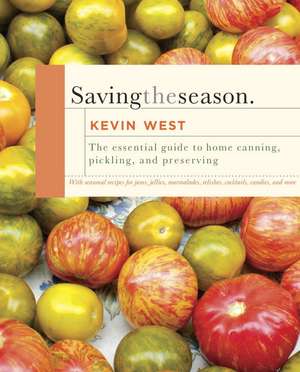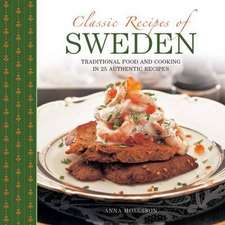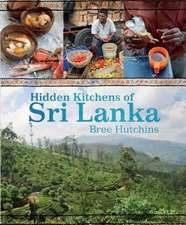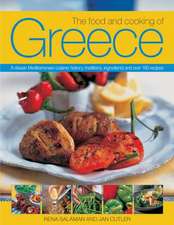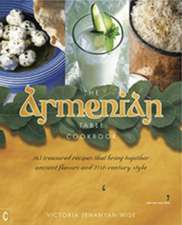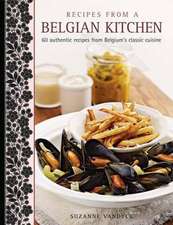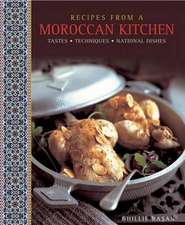Saving the Season: A Cook's Guide to Home Canning, Pickling, and Preserving
Autor Kevin Westen Limba Engleză Hardback – 24 iun 2013
A Los Angeles Times Holiday Gift-Giving Pick
An Amazon Best Cookbook & Food Writing Book of the Year
Strawberry jam. Pickled beets. Homegrown tomatoes. These are the tastes of Kevin West's Southern childhood, and they are the tastes that inspired him to "save the season," as he traveled from the citrus groves of Southern California to the cranberry bogs of Massachusetts and everywhere in between, chronicling America's rich preserving traditions.
Here, West presents his findings: 220 recipes for sweet and savory jams, pickles, cordials, cocktails, candies, and more; plus 300 full-color photographs. From Classic Apricot Jam to Green Tomato Chutney; from Pickled Asparagus with Tarragon and Green Garlic to Scotch Marmalade, Saving the Season is the ultimate guide for cooks - from the novice to the professional - and the only book you need to save (and savor) the season throughout the entire year.
Preț: 284.63 lei
Nou
Puncte Express: 427
Preț estimativ în valută:
54.47€ • 59.15$ • 45.76£
54.47€ • 59.15$ • 45.76£
Carte disponibilă
Livrare economică 02-16 aprilie
Preluare comenzi: 021 569.72.76
Specificații
ISBN-13: 9780307599483
ISBN-10: 0307599485
Pagini: 544
Ilustrații: 322 PHOTOS IN TXT, PPR / BDS
Dimensiuni: 192 x 240 x 33 mm
Greutate: 1.59 kg
Ediția:New.
Editura: Knopf Publishing Group
ISBN-10: 0307599485
Pagini: 544
Ilustrații: 322 PHOTOS IN TXT, PPR / BDS
Dimensiuni: 192 x 240 x 33 mm
Greutate: 1.59 kg
Ediția:New.
Editura: Knopf Publishing Group
Notă biografică
KEVIN WEST is from rural Blount County in eastern Tennessee. He attended Deep Springs, an experimental college in the White Mountains of California, and Sewanee: The University of the South. For thirteen years he was on the staff at W magazine, with postings in New York, Paris, and Los Angeles, where he was West Coast editor and where he still lives. He runs the blog SavingtheSeason.com; writes about food, culture, and travel; and produces a retail collection of jams and marmalades. He is certified as a Master Food Preserver by the University of California Cooperative Extension.
Extras
From Saving the Season
-
NOCINO
Yields about 5 cups
June 24 is the Nativity of Saint John the Baptist, the traditional day to harvest green walnuts for making nocino, a delicious liqueur invented at a congress of witches, according to Anna Tasca Lanza, the doyenne of Sicilian cooking. Lanza’s witches were Italian, but other countries from Croatia to France to the chilly Teutonic regions equally claim greenwalnut liqueur as their own. I learned to make it at the Institute of Domestic Technology, a cooking school in Altadena, California, where I also teach. When you harvest the nuts—working barefoot, according to some folklore—they are smaller than eggs, smooth to the touch, and crisp like apples, because the shells have not yet hardened. The nutmeats, at this stage, are jelly. Like most liqueurs, nocino is easy but requires patience. You slice the nuts and cover them with strong booze, sugar, and spice, and allow the mixture to infuse for forty days, until it is nearly black. The real test of patience begins after you bottle it. Ten-year-old nocino is said to be the best, and certainly you would never drink this summer’s batch before cold weather sets in this fall. Mature nocino has a complex flavor of nutmeg, allspice, coffee, and caramel. Drink it neat as a digestif, or use it to flavor desserts. A few tablespoons of nocino lightly whisked into a cup of heavy cream will cause it to seize, as if magically transformed into cooked custard. The thickened cream is called “posset,” and can be used as a sauce alongside cakes or other desserts.
My nocino recipe is based on those from the Institute of Domestic Technology and Lanza’s Sicilian cookbook The Garden of Endangered Fruit. Its fundamentals are green walnuts, 80-proof grain spirits, and sugar. (My secret ingredient is coffee beans.)You can change the aromatics if you like, but use small quantities, because the spices can take over. Green walnuts are sometimes available at farmers’ markets, or can be ordered online at www.localharvest.org.
2 pounds green English walnuts, 1½ inches or less in diameter (about 30)
750 milliliters 80-proof vodka
3½ cups sugar
Zest of 1 lemon, in strips
Zest of 1 orange, in strips
5 cloves
¼ whole nutmeg
1 heaping teaspoon whole dark-roast coffee beans
1. Quarter the walnuts and place them in a large glass jar, at least 3-quart capacity. Add the remaining ingredients and stir. Don’t worry that the sugar won’t immediately dissolve. Seal the jar, and place it in a sunny place for 40 days. The liquid will first turn a sinister green, then black. Once every 10 days, agitate the jar by inverting it a time or two. You can taste the alcohol at any stage and add more aromatics if you like.
2. After 40 days, strain the contents of the jar through a damp jelly bag and catch the liquids in a bowl. Funnel the liqueur into scalded bottles, and seal. Store in a cool, dark place for several months; Lanza suggests opening them on All Saints’ Day. Before serving, you may want to strain the liqueur through a coffee filter to remove sediments, but it isn’t necessary to do so. The liqueur will keep indefinitely without refrigeration.
-
CUCUMBER DILL SPEARS AND CHIPS
Yields 2 quarts
On page 39, I explain that processing your pickles in a hot-water bath rather than a boiling-water bath will give you a firmer texture. It follows that if you want pickles with real snap, don’t process them at all. These dill-pickle spears—or sandwich chips, depending on how you slice them—can be processed, if you want, for long- term shelf storage, but first try making a batch to keep in the refrigerator. They will be crisp, and the flavor of raw cucumber comes through. It’s the freshest-tasting pickle in this book, and perhaps my favorite. The recipe can be scaled up.
¼ cup kosher salt
6 cups lukewarm water
2 teaspoons coriander seeds
½ teaspoon fennel seeds
3 large flowering dill heads (4 inches across)
3 pounds Kirby pickling cucumbers
4 cloves garlic, crushed
2 cups white- wine vinegar
1. Dissolve the salt in the water, and add the coriander, fennel, and dill. Set aside.
2. Scrub the cucumbers well, rubbing off any spines. Cut away a thin round from the stem and blossom ends, and slice lengthwise into quarters. Put the spears in a large bowl, and cover with the brine. Weight the cucumbers with a plate, cover the bowl with a kitchen towel, and set aside for 24 hours. If the bowl won’t fit in your refrigerator, it’s fine to leave it out at room temperature.
3. The next day, pack the cucumber spears into two scalded quart jars, saving the brine. Measure out 2 cups of the brine and reserve. Strain the remaining brine through a fi ne sieve to capture the aromatics, and divide them between the jars. Tuck a dill head and two cloves of garlic into each jar.
4. Mix the vinegar and the 2 cups reserved brine, and bring to a boil. Pour it over the pickles to cover. Seal the jars, and store in the refrigerator for a week before using. For long- term shelf storage, leave ½ inch headspace when filling the jars, then seal. Process in a boiling- water bath for 10 minutes, or in a hot- water bath, between 180 and 185 degrees, for 30 minutes.
[Note] Instead of spears, you could slice your cucumbers into round coins, lengthwise “slabs,” or bias-cut ovals. Make the slices 3⁄8 inch thick and soak them in the brine for 12 hours instead of 24.
-
CHUTNEY
Yields 4 pints
When you’re making preserves, fully 50 percent of your success is in the shopping—good fruit makes good jam. Technique matters also, and a sound recipe makes a difference. But the crucial remaining factor is organization. Especially when dealing with a large quantity of perishable fruits or vegetables, you have to think through your strategy and plot out your work. If you can’t get everything put up immediately, you have to take into account how the produce will ripen—and soon fade—as it waits for you. My strategy for how to use a bushel of peaches would look something like this:
First day/underripe fruit: Pectin levels peak just before ripening, so I’d start with peach jelly, using the same technique as for Apricot Jelly on page 184. If you don’t want to make jelly, give the peaches another day to ripen.
First day/just-ripe fruit: Peaches that are fragrant and slightly yielding but still firm enough to handle are ideal for canning in syrup, as either halves or slices in syrup.
Second day/fully ripe fruit: As the peaches become tender and fragrant, make jam.
Third day/dead-ripe fruit: By now, the peaches will likely have a few brown spots that will need to be cut away, so I’d work up a batch of chutney, which requires long, slow cooking that breaks down the fruit anyway.
Fourth day/tired fruit: Whatever peaches haven’t been used by now will likely look a little sad, but even really soft, spotty ones can be trimmed for a batch of Spiced Peach Butter (page 239). Southern peach chutney evolved from an Indian relish called chatni that British colonials brought home during the days when the sun never set on the Empire. According to The Oxford Companion to Food, chatni is made fresh before a meal by grinding spices and adding them to a paste of tamarind, garlic, and limes or coconut. Pieces of fruit or vegetable may be incorporated, but the chief flavor characteristic is sour. The British turned that into a fruit preserve, explains the Oxford Companion: British chutneys are usually spiced, sweet, fruit pickles, having something of the consistency of jam. Highest esteem is accorded to mango chutney. . . .Chutney later spread across the Atlantic to the West Indies and the American South, where the esteemed mango was replaced by the honorable peach.
5 pounds yellow peaches or nectarines, peeled and cut into ½-inch cubes
3 cups organic or turbinado sugar
2 cups apple-cider vinegar
¾ cup raisins
1 cup chopped Vidalia onion
1 sweet banana pepper or ½ yellow bell pepper, diced
2 or 3 fresh green jalapeños, diced, or adjust to taste
2 cloves garlic, minced
2 tablespoons grated fresh ginger root
2 teaspoons freshly grated turmeric, or ½ teaspoon ground
4 tablespoons mustard seeds
1 teaspoon garam masala (a ground spice mixture containing pepper, cloves, cinnamon, cardamom, coriander, nutmeg, cumin, and star anise)
2 teaspoons Darjeeling tea (or 4 tea bags)
1. Combine all the ingredients in a deep pot, and bring to a boil. Moderate the heat, and reduce for as long as an hour, until all the excess liquid boils away and what remains is thick and jamlike in texture. Be sure to taste the chutney at several points, and adjust the seasonings to your preference. Chutney should be deeply flavored and complex, with at least a bit of spicy heat. If you like the bright taste of green chilies, add more minced jalapeños during the last 10 minutes of cooking.
2. Ladle the hot chutney into four prepared pint jars, leaving ¼ inch headspace. Seal, and process in a boiling- water bath for 10 minutes. Allow to cure for a month before eating.
-
NOCINO
Yields about 5 cups
June 24 is the Nativity of Saint John the Baptist, the traditional day to harvest green walnuts for making nocino, a delicious liqueur invented at a congress of witches, according to Anna Tasca Lanza, the doyenne of Sicilian cooking. Lanza’s witches were Italian, but other countries from Croatia to France to the chilly Teutonic regions equally claim greenwalnut liqueur as their own. I learned to make it at the Institute of Domestic Technology, a cooking school in Altadena, California, where I also teach. When you harvest the nuts—working barefoot, according to some folklore—they are smaller than eggs, smooth to the touch, and crisp like apples, because the shells have not yet hardened. The nutmeats, at this stage, are jelly. Like most liqueurs, nocino is easy but requires patience. You slice the nuts and cover them with strong booze, sugar, and spice, and allow the mixture to infuse for forty days, until it is nearly black. The real test of patience begins after you bottle it. Ten-year-old nocino is said to be the best, and certainly you would never drink this summer’s batch before cold weather sets in this fall. Mature nocino has a complex flavor of nutmeg, allspice, coffee, and caramel. Drink it neat as a digestif, or use it to flavor desserts. A few tablespoons of nocino lightly whisked into a cup of heavy cream will cause it to seize, as if magically transformed into cooked custard. The thickened cream is called “posset,” and can be used as a sauce alongside cakes or other desserts.
My nocino recipe is based on those from the Institute of Domestic Technology and Lanza’s Sicilian cookbook The Garden of Endangered Fruit. Its fundamentals are green walnuts, 80-proof grain spirits, and sugar. (My secret ingredient is coffee beans.)You can change the aromatics if you like, but use small quantities, because the spices can take over. Green walnuts are sometimes available at farmers’ markets, or can be ordered online at www.localharvest.org.
2 pounds green English walnuts, 1½ inches or less in diameter (about 30)
750 milliliters 80-proof vodka
3½ cups sugar
Zest of 1 lemon, in strips
Zest of 1 orange, in strips
5 cloves
¼ whole nutmeg
1 heaping teaspoon whole dark-roast coffee beans
1. Quarter the walnuts and place them in a large glass jar, at least 3-quart capacity. Add the remaining ingredients and stir. Don’t worry that the sugar won’t immediately dissolve. Seal the jar, and place it in a sunny place for 40 days. The liquid will first turn a sinister green, then black. Once every 10 days, agitate the jar by inverting it a time or two. You can taste the alcohol at any stage and add more aromatics if you like.
2. After 40 days, strain the contents of the jar through a damp jelly bag and catch the liquids in a bowl. Funnel the liqueur into scalded bottles, and seal. Store in a cool, dark place for several months; Lanza suggests opening them on All Saints’ Day. Before serving, you may want to strain the liqueur through a coffee filter to remove sediments, but it isn’t necessary to do so. The liqueur will keep indefinitely without refrigeration.
-
CUCUMBER DILL SPEARS AND CHIPS
Yields 2 quarts
On page 39, I explain that processing your pickles in a hot-water bath rather than a boiling-water bath will give you a firmer texture. It follows that if you want pickles with real snap, don’t process them at all. These dill-pickle spears—or sandwich chips, depending on how you slice them—can be processed, if you want, for long- term shelf storage, but first try making a batch to keep in the refrigerator. They will be crisp, and the flavor of raw cucumber comes through. It’s the freshest-tasting pickle in this book, and perhaps my favorite. The recipe can be scaled up.
¼ cup kosher salt
6 cups lukewarm water
2 teaspoons coriander seeds
½ teaspoon fennel seeds
3 large flowering dill heads (4 inches across)
3 pounds Kirby pickling cucumbers
4 cloves garlic, crushed
2 cups white- wine vinegar
1. Dissolve the salt in the water, and add the coriander, fennel, and dill. Set aside.
2. Scrub the cucumbers well, rubbing off any spines. Cut away a thin round from the stem and blossom ends, and slice lengthwise into quarters. Put the spears in a large bowl, and cover with the brine. Weight the cucumbers with a plate, cover the bowl with a kitchen towel, and set aside for 24 hours. If the bowl won’t fit in your refrigerator, it’s fine to leave it out at room temperature.
3. The next day, pack the cucumber spears into two scalded quart jars, saving the brine. Measure out 2 cups of the brine and reserve. Strain the remaining brine through a fi ne sieve to capture the aromatics, and divide them between the jars. Tuck a dill head and two cloves of garlic into each jar.
4. Mix the vinegar and the 2 cups reserved brine, and bring to a boil. Pour it over the pickles to cover. Seal the jars, and store in the refrigerator for a week before using. For long- term shelf storage, leave ½ inch headspace when filling the jars, then seal. Process in a boiling- water bath for 10 minutes, or in a hot- water bath, between 180 and 185 degrees, for 30 minutes.
[Note] Instead of spears, you could slice your cucumbers into round coins, lengthwise “slabs,” or bias-cut ovals. Make the slices 3⁄8 inch thick and soak them in the brine for 12 hours instead of 24.
-
CHUTNEY
Yields 4 pints
When you’re making preserves, fully 50 percent of your success is in the shopping—good fruit makes good jam. Technique matters also, and a sound recipe makes a difference. But the crucial remaining factor is organization. Especially when dealing with a large quantity of perishable fruits or vegetables, you have to think through your strategy and plot out your work. If you can’t get everything put up immediately, you have to take into account how the produce will ripen—and soon fade—as it waits for you. My strategy for how to use a bushel of peaches would look something like this:
First day/underripe fruit: Pectin levels peak just before ripening, so I’d start with peach jelly, using the same technique as for Apricot Jelly on page 184. If you don’t want to make jelly, give the peaches another day to ripen.
First day/just-ripe fruit: Peaches that are fragrant and slightly yielding but still firm enough to handle are ideal for canning in syrup, as either halves or slices in syrup.
Second day/fully ripe fruit: As the peaches become tender and fragrant, make jam.
Third day/dead-ripe fruit: By now, the peaches will likely have a few brown spots that will need to be cut away, so I’d work up a batch of chutney, which requires long, slow cooking that breaks down the fruit anyway.
Fourth day/tired fruit: Whatever peaches haven’t been used by now will likely look a little sad, but even really soft, spotty ones can be trimmed for a batch of Spiced Peach Butter (page 239). Southern peach chutney evolved from an Indian relish called chatni that British colonials brought home during the days when the sun never set on the Empire. According to The Oxford Companion to Food, chatni is made fresh before a meal by grinding spices and adding them to a paste of tamarind, garlic, and limes or coconut. Pieces of fruit or vegetable may be incorporated, but the chief flavor characteristic is sour. The British turned that into a fruit preserve, explains the Oxford Companion: British chutneys are usually spiced, sweet, fruit pickles, having something of the consistency of jam. Highest esteem is accorded to mango chutney. . . .Chutney later spread across the Atlantic to the West Indies and the American South, where the esteemed mango was replaced by the honorable peach.
5 pounds yellow peaches or nectarines, peeled and cut into ½-inch cubes
3 cups organic or turbinado sugar
2 cups apple-cider vinegar
¾ cup raisins
1 cup chopped Vidalia onion
1 sweet banana pepper or ½ yellow bell pepper, diced
2 or 3 fresh green jalapeños, diced, or adjust to taste
2 cloves garlic, minced
2 tablespoons grated fresh ginger root
2 teaspoons freshly grated turmeric, or ½ teaspoon ground
4 tablespoons mustard seeds
1 teaspoon garam masala (a ground spice mixture containing pepper, cloves, cinnamon, cardamom, coriander, nutmeg, cumin, and star anise)
2 teaspoons Darjeeling tea (or 4 tea bags)
1. Combine all the ingredients in a deep pot, and bring to a boil. Moderate the heat, and reduce for as long as an hour, until all the excess liquid boils away and what remains is thick and jamlike in texture. Be sure to taste the chutney at several points, and adjust the seasonings to your preference. Chutney should be deeply flavored and complex, with at least a bit of spicy heat. If you like the bright taste of green chilies, add more minced jalapeños during the last 10 minutes of cooking.
2. Ladle the hot chutney into four prepared pint jars, leaving ¼ inch headspace. Seal, and process in a boiling- water bath for 10 minutes. Allow to cure for a month before eating.
Recenzii
“[West’s] bio alone made me want Saving the Season, but now that I’ve got it I’m buying a copy for everyone I know. . . . There are many lovely preserving books out there, but this comprehensive compendium is a canning category killer.”
—Edible Manhattan
“A terrific guide to home canning and preserving. . . . Happily for home cooks, West is a small-batch kind of guy. He rarely calls for more than 3 pounds of any fruit or vegetable, so if an experiment goes awry (as preserving experiments will, especially in the early stages), the damage isn't too severe. . . . Not that that's so much of a concern. West's instructions are clear and precise, and his explanations of what is going on are thorough. “
—Philly.com
“A pleasure to read. West includes short profiles of his favorite farmers and farm adventures, from Santa Monica market heroes such as Windrose Farms’ Bill and Barbara Spencer, to a weekend-long ramp dig in West Virginia. . . . As pleasurable (and useful) for the somewhat experienced canner as it is for the novice. . . . West’s instructions are clear and precise. . . . He’s got a good cook’s curiosity, always wondering why things work the way they do and constantly on the lookout for new ideas. . . . Just leafing through the book, I found myself thinking ‘Hmmm, I’ve got all those strawberries in the refrigerator.’”
—Los Angeles Times
“Pleasant surprises await, in the book's unusual recipes and in the author's pectinlike ability to find the right set for blending food lit, essays and smart seasonality.”
—The Philadelphia Inquirer
“West offers ideas for using what you’ve canned, pickled and preserved in unusual ways. . . . [Saving the Season] contains recipes you won’t come across in the traditional canning manuals: pickled green almonds, which West suggests to replace olives in a martini; your own capers made from nasturtium pods. . . . I can already see the jars lined up in my pantry.”
—The Register-Guard
“Encyclopedic. . . . West charts a personal, literary and cultural history of ‘putting up’ over the course of more than 500 pages, 220 recipes, and numerous essays. Writing on everything from food safety to Adriaen Corrte’s 1704 painting Wild Strawberries in a Wan Li Bowl. . . . [He] possesses a rare ability. He can make a damn good jar of spiced fig jam and writes beautifully. . . . [And] he initiates the culinary handshake, and knowingly sparks the conversation, putting all parties at ease—this canning thing can be easy, delicious and fun. . . . Organized according to the season, West’s book can be pulled and put to use at any time of year.”
—TakePart
“A very creative book for the summer canning season. . . . West is an excellent story teller. . . . [He] has written a book that goes beyond the usual fruits, vegetables and pickles. . . . There is enough on marmalades to fill three cookbooks. . . . [It’s] a pleasure reading someone who writes so well and has such fun, interesting side stories to tell. I know I’ll be turning to it quite a bit this summer.”
—Narsai David, Food & Wine Editor, KCBS (San Francisco)
“This cookbook is unlike any other on my shelf. West approaches his topic—home canning and preserving—with a reporter's attention to detail and a poet's sensibility; it's less a canning tutorial and cookbook than it is a collection of absorbing personal essays, literary excerpts, explications of culinary history, and friendly advice, all of which happens to be punctuated by appealing, easy-to-follow recipes. . . . The text dances on, its cadence dictated by the season, and while there are more than enough spring and summer recipes to keep you busy every weekend from now through the end of August (I, for one, can't wait to make my own Maraschino cherries), West's engaging stories will probably have you reading ahead, looking forward to homemade pumpkin butter and blood orange marmalade.”
—Saveur.com
“I love Kevin West's beautiful new book about canning, pickling, and preserving.”
—Alice Waters
“Part cookbook, part manifesto, and part crypto-memoir . . . literate and lyrical and fanatically well researched. . . . The kind of cookbook you can read for pleasure. . . . It has more than 200 recipes but is shot through with little essays, too—about preserving, food gathering, gardening, family.”
—John Jeremiah Sullivan, Lucky Peach
“When is the last time you wanted to read a cookbook, not just use its recipes? . . . There have been bushels of cookbooks published on home preserving in recent years, but this comprehensive collection of more than 200 recipes is an essential guide for accomplished canners . . . as well as novices. . . . Author Kevin West's writing is beautiful, revealing canning lessons learned from friends [and] the traditions behind American preserving. . . . Filled with personal stories that show the connection between the garden and the dinner table, and how that can be extended to offer tastes of summer in the middle of winter. . . . There's so much wisdom here it's hard to put down, and literary references to opera, poetry and great writers open up a deeper level of thinking than most cookbooks can conjure.”
—The Oregonian
“If you're looking to perfect your marmalade technique or learn how to make ‘canned’ salmon . . . , West will show you how. More interested in scavenging for pyrachantha berries on common L.A. sidewalk ground to make a jelly? You'll find useful tips here, too. . . . Regardless of your homemade cornichon and peach jam making experience, it's the stories here that will make you want to try West's versions. . . . We love how genuine West's personal reflections feel in an age when recipe headers often read like they came straight out of a ‘branding 101’ blog convention seminar. . . . It's earned a permanent spot on our cookbook shelf.”
—LA Weekly (blog)
“Saving the Season reminds us why we preserve, its pages rich with the cuisine and culture we are connected to any time we stir a pot of jam or put up a jar of pickles. . . . Transcends what you might normally think of when you imagine a preserving cookbook. Both academic and soulful, it's the sort of book that you can carry into the kitchen, curl up with on the couch, and rely on for reference. . . . [Perfect for] anyone who likes cooking and seasonal eating, including both new and experienced food preservers; appreciators of history, art, literature, science, and culture. . . . If you buy only one preserving cookbook this year, or perhaps even in your lifetime, promise me you'll make it this one.”
—The Kitchn.com
“The secret corner where nostalgia meets innovation is where all food thinkers do their best work. Kevin West carves out that nook for you. . . . Traditional and quirky alike, Saving the Season is an endearing, romantic, and most of all practical resource for everyone — whether [you are] cleaning out the fridge, making the rounds at the greenmarket or just late to a strawberry picking date with Grandma. I, for one, am inspired and obsessed!”
—Christina Tosi, author of Momofuku Milk Bar
“Kevin West’s enthusiasm is infectious and his recipes seductive. Whether you are at work in the kitchen or savoring it in your armchair, great pleasures await within in the pages of Saving the Season.”
—Scott Peacock, co-author of The Gift of Southern Cooking
“Saving the Season is smart, romantic, poetic, and practical. . . . A damned good read and gorgeous photos, too.”
—David Tanis, author of A Platter of Figs and Other Recipes
“A bounty of jelly, marmalade and pickle recipes, timely and timeless for today’s cult of domesticity.”
—C, California Style magazine
“[A] liberal arts approach to recipes and stories focusing on . . . cuisine and culture. . . . About the past as much as the present.”
—Women’s Wear Daily
“This cookbook by West, journalist and home-canning blogger, venerates the art of ‘putting up’ seasonal bounty of regional hillside orchards, forests, and gardens. Southern roots and childhood memories of home canning with grandparents inspire West's passion for capturing the taste of the seasons in a jar. In an impressive practical guide rich in storytelling and culinary information, this self-described urban dweller who doesn't garden provides a thorough compendium of essential techniques for preserving the harvest.. . . . Because ‘nature's bounty is abundant but fleeting,’ West shows home cooks how to save the season through the tradition of canning.”
—Publishers Weekly
“West, who is certified as a master food preserver by the University of California Cooperative Extension, explores the various preserves available through the four seasons. Each base recipe includes variations to please any palate. . . . Appendixes of peak seasons by region and tables of fruit varieties provide extensive information for cooks in any region. More than just recipes, the book also contains stories of the author’s travels throughout the States, as well as regional preserving traditions. . . . A lot of information is packed into [Saving the Season], covering the basics of preserving along with easy to advanced recipes. The combination of recipes and musings makes this a great read both in and out of the kitchen.”
—Library Journal
“With the present obsession among consumers for locally grown fruits and vegetables, the practice of putting up foods has undergone a renaissance. As West points out, the real goal of home canning, pickling, and preserving is to retain for future enjoyment the special flavors of foods freshly plucked from the earth or snatched from trees and vines. West’s recipes, clearly written, cover everything from dill pickles to complex marmalades. Antique fruits appear as well as fiery kimchi. In addition to his recipes, West has scattered through the text reminiscences, anecdotes, and reflections on personalities associated in some way to the world of canning and preserving. . . . West’s guide will prove invaluable.”
—Booklist
—Edible Manhattan
“A terrific guide to home canning and preserving. . . . Happily for home cooks, West is a small-batch kind of guy. He rarely calls for more than 3 pounds of any fruit or vegetable, so if an experiment goes awry (as preserving experiments will, especially in the early stages), the damage isn't too severe. . . . Not that that's so much of a concern. West's instructions are clear and precise, and his explanations of what is going on are thorough. “
—Philly.com
“A pleasure to read. West includes short profiles of his favorite farmers and farm adventures, from Santa Monica market heroes such as Windrose Farms’ Bill and Barbara Spencer, to a weekend-long ramp dig in West Virginia. . . . As pleasurable (and useful) for the somewhat experienced canner as it is for the novice. . . . West’s instructions are clear and precise. . . . He’s got a good cook’s curiosity, always wondering why things work the way they do and constantly on the lookout for new ideas. . . . Just leafing through the book, I found myself thinking ‘Hmmm, I’ve got all those strawberries in the refrigerator.’”
—Los Angeles Times
“Pleasant surprises await, in the book's unusual recipes and in the author's pectinlike ability to find the right set for blending food lit, essays and smart seasonality.”
—The Philadelphia Inquirer
“West offers ideas for using what you’ve canned, pickled and preserved in unusual ways. . . . [Saving the Season] contains recipes you won’t come across in the traditional canning manuals: pickled green almonds, which West suggests to replace olives in a martini; your own capers made from nasturtium pods. . . . I can already see the jars lined up in my pantry.”
—The Register-Guard
“Encyclopedic. . . . West charts a personal, literary and cultural history of ‘putting up’ over the course of more than 500 pages, 220 recipes, and numerous essays. Writing on everything from food safety to Adriaen Corrte’s 1704 painting Wild Strawberries in a Wan Li Bowl. . . . [He] possesses a rare ability. He can make a damn good jar of spiced fig jam and writes beautifully. . . . [And] he initiates the culinary handshake, and knowingly sparks the conversation, putting all parties at ease—this canning thing can be easy, delicious and fun. . . . Organized according to the season, West’s book can be pulled and put to use at any time of year.”
—TakePart
“A very creative book for the summer canning season. . . . West is an excellent story teller. . . . [He] has written a book that goes beyond the usual fruits, vegetables and pickles. . . . There is enough on marmalades to fill three cookbooks. . . . [It’s] a pleasure reading someone who writes so well and has such fun, interesting side stories to tell. I know I’ll be turning to it quite a bit this summer.”
—Narsai David, Food & Wine Editor, KCBS (San Francisco)
“This cookbook is unlike any other on my shelf. West approaches his topic—home canning and preserving—with a reporter's attention to detail and a poet's sensibility; it's less a canning tutorial and cookbook than it is a collection of absorbing personal essays, literary excerpts, explications of culinary history, and friendly advice, all of which happens to be punctuated by appealing, easy-to-follow recipes. . . . The text dances on, its cadence dictated by the season, and while there are more than enough spring and summer recipes to keep you busy every weekend from now through the end of August (I, for one, can't wait to make my own Maraschino cherries), West's engaging stories will probably have you reading ahead, looking forward to homemade pumpkin butter and blood orange marmalade.”
—Saveur.com
“I love Kevin West's beautiful new book about canning, pickling, and preserving.”
—Alice Waters
“Part cookbook, part manifesto, and part crypto-memoir . . . literate and lyrical and fanatically well researched. . . . The kind of cookbook you can read for pleasure. . . . It has more than 200 recipes but is shot through with little essays, too—about preserving, food gathering, gardening, family.”
—John Jeremiah Sullivan, Lucky Peach
“When is the last time you wanted to read a cookbook, not just use its recipes? . . . There have been bushels of cookbooks published on home preserving in recent years, but this comprehensive collection of more than 200 recipes is an essential guide for accomplished canners . . . as well as novices. . . . Author Kevin West's writing is beautiful, revealing canning lessons learned from friends [and] the traditions behind American preserving. . . . Filled with personal stories that show the connection between the garden and the dinner table, and how that can be extended to offer tastes of summer in the middle of winter. . . . There's so much wisdom here it's hard to put down, and literary references to opera, poetry and great writers open up a deeper level of thinking than most cookbooks can conjure.”
—The Oregonian
“If you're looking to perfect your marmalade technique or learn how to make ‘canned’ salmon . . . , West will show you how. More interested in scavenging for pyrachantha berries on common L.A. sidewalk ground to make a jelly? You'll find useful tips here, too. . . . Regardless of your homemade cornichon and peach jam making experience, it's the stories here that will make you want to try West's versions. . . . We love how genuine West's personal reflections feel in an age when recipe headers often read like they came straight out of a ‘branding 101’ blog convention seminar. . . . It's earned a permanent spot on our cookbook shelf.”
—LA Weekly (blog)
“Saving the Season reminds us why we preserve, its pages rich with the cuisine and culture we are connected to any time we stir a pot of jam or put up a jar of pickles. . . . Transcends what you might normally think of when you imagine a preserving cookbook. Both academic and soulful, it's the sort of book that you can carry into the kitchen, curl up with on the couch, and rely on for reference. . . . [Perfect for] anyone who likes cooking and seasonal eating, including both new and experienced food preservers; appreciators of history, art, literature, science, and culture. . . . If you buy only one preserving cookbook this year, or perhaps even in your lifetime, promise me you'll make it this one.”
—The Kitchn.com
“The secret corner where nostalgia meets innovation is where all food thinkers do their best work. Kevin West carves out that nook for you. . . . Traditional and quirky alike, Saving the Season is an endearing, romantic, and most of all practical resource for everyone — whether [you are] cleaning out the fridge, making the rounds at the greenmarket or just late to a strawberry picking date with Grandma. I, for one, am inspired and obsessed!”
—Christina Tosi, author of Momofuku Milk Bar
“Kevin West’s enthusiasm is infectious and his recipes seductive. Whether you are at work in the kitchen or savoring it in your armchair, great pleasures await within in the pages of Saving the Season.”
—Scott Peacock, co-author of The Gift of Southern Cooking
“Saving the Season is smart, romantic, poetic, and practical. . . . A damned good read and gorgeous photos, too.”
—David Tanis, author of A Platter of Figs and Other Recipes
“A bounty of jelly, marmalade and pickle recipes, timely and timeless for today’s cult of domesticity.”
—C, California Style magazine
“[A] liberal arts approach to recipes and stories focusing on . . . cuisine and culture. . . . About the past as much as the present.”
—Women’s Wear Daily
“This cookbook by West, journalist and home-canning blogger, venerates the art of ‘putting up’ seasonal bounty of regional hillside orchards, forests, and gardens. Southern roots and childhood memories of home canning with grandparents inspire West's passion for capturing the taste of the seasons in a jar. In an impressive practical guide rich in storytelling and culinary information, this self-described urban dweller who doesn't garden provides a thorough compendium of essential techniques for preserving the harvest.. . . . Because ‘nature's bounty is abundant but fleeting,’ West shows home cooks how to save the season through the tradition of canning.”
—Publishers Weekly
“West, who is certified as a master food preserver by the University of California Cooperative Extension, explores the various preserves available through the four seasons. Each base recipe includes variations to please any palate. . . . Appendixes of peak seasons by region and tables of fruit varieties provide extensive information for cooks in any region. More than just recipes, the book also contains stories of the author’s travels throughout the States, as well as regional preserving traditions. . . . A lot of information is packed into [Saving the Season], covering the basics of preserving along with easy to advanced recipes. The combination of recipes and musings makes this a great read both in and out of the kitchen.”
—Library Journal
“With the present obsession among consumers for locally grown fruits and vegetables, the practice of putting up foods has undergone a renaissance. As West points out, the real goal of home canning, pickling, and preserving is to retain for future enjoyment the special flavors of foods freshly plucked from the earth or snatched from trees and vines. West’s recipes, clearly written, cover everything from dill pickles to complex marmalades. Antique fruits appear as well as fiery kimchi. In addition to his recipes, West has scattered through the text reminiscences, anecdotes, and reflections on personalities associated in some way to the world of canning and preserving. . . . West’s guide will prove invaluable.”
—Booklist
Descriere
A stylish, richly illustrated, practical guide for home cooks and preserving enthusiasts, the first cookbook from journalist West, author of the popular blog Savingtheseason.com. Incorporating classic favorites and new flavors, West offers more than 100 recipes, organized by season, for sweet preserves and savory pickles, easy-to-can vegetables and fruits, and condiments.
